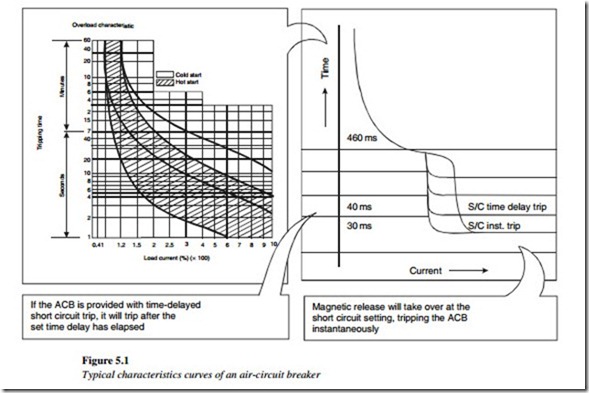Molded case circuit breakers
These are circuit breakers with tripping mechanisms and terminal contacts assembled together in a molded case.
This helps in getting high die-electric strength as well as mechanical strength to it. In addition, an arc chute is provided to increase the length of the arc and at the same time restricting hot gases that come in contact with the important parts of the breaker.
Molded case circuit breakers (MCCB) with ratings up to 3000 A are capable of interrupting currents up to 200 kA. These are used for the control of low-voltage networks.
Oil circuit breakers
The arc decomposes in dielectric oil. The gases formed due to the decomposition are channeled through a vent in the chamber.
Oil circuit breakers are popular for high-voltage distribution systems, despite the perceived fire risk. These consist of an oil enclosure, in which the contacts and an arc
control device are mounted. The arc is kept within the control device and the resultant gas pressure sweeps the arc, through the cooling vents in the side of the pot. There is a possibility of an explosion due to rise in pressure. In addition, these circuit breakers require regular replacement of oil as dielectric strength reduces during arcing.
They are not suitable for applications where breakers operate repeatedly. The oil circuit breakers are commonly used up to the voltage level of 145 kV.
Air-circuit breakers
In this type of breakers, air (at atmospheric pressure) is used for arc extinguishing. It uses the high-resistance interruption principle. The length of an arc is increased by using arc chutes and arc runners.
They are used in AC and DC circuits up to 11 kV. They are generally of an indoor type for medium- and low-voltage applications. They are simple in construction, indoor type,
panel-mounted and have current-limiting properties. They are particularly suitable for applications where repeated breaking is required. The operation can be manual as well as automatic.
The manual operating mechanisms can be either by spring or by motor charging, whereas in the automatic mode it can be through the solenoid coil.
The air-break circuit breaker for 3.3–11 kV has an arc control device, which is suitable for motor switching and is used mainly in power stations.
Typical characteristic curves of an air-circuit breaker are shown in Figure 5.1.
Vacuum circuit breakers
When two current-carrying contacts are separated in a vacuum chamber, an arc is drawn between them. With an AC, the current decreases during a portion of the wave and then tends to zero. This principle is used in these breakers.
Vacuum circuit breakers were the first type of oil-less circuit breakers. Vacuum interrupters are sealed for life in ceramic bottles. These bottles contain movable contacts in a high vacuum. The circuit breaking performance of this design is very high and a large number of short-circuit operations can be achieved before any replacement is necessary.
Vacuum circuit breakers are used for duties that require the following:
• Very high electrical and mechanical life
• Concealed current path
• Compactness.
The advantages of a vacuum circuit breaker are listed as follows:
• No exposed arc
• High operating safety due to reliable switching on high short-circuit faults
• Longer electrical life of up to 30 000 operating cycles at rated current
• High short time current withstanding capability
• Extremely short fault clearance time
• Integrated voltage suppressor
• Contact erosion indicator for erosion monitoring
• Maintenance-free current path.
SF6 circuit breakers
SF6 gas is an inert gas with dielectric strength and arc-extinguishing qualities. In SF6 breakers, the rate of rise of dielectric strength is very high and the time constant is very small. This provides another type of oil-less circuit breaker. However, the life of the contacts is short when compared to that of the vacuum circuit breaker.
The SF6 circuit breaker has other advantages that make it equally acceptable for industrial use. All circuit breaker systems up to 36 kV are three-phase systems. However,
for higher voltages of up to 420 kV, three separate single-phase breakers are sometimes used to facilitate the single-phase opening and the closing for transient faults. The advantages of SF6 breakers are as follows:
• There is no danger of explosion or fire
• Excellent arc-extinguishing capabilities with minimum time
• Contacts wear and tear is lesser
• Outdoor SF6 breakers are simple, cheap, maintenance-free, and compact
• Suitable for voltage levels ranging from 3.6 to 760 kV
• Minimum maintenance
• No contamination of moisture or dust due to sealed construction.
